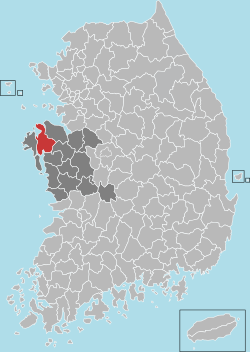Seosan
| Seosan 서산 | ||
|---|---|---|
| Municipal City | ||
| Korean transcription(s) | ||
| • Hangul | 서산시 | |
| • Hanja | 瑞山市 | |
| • Revised Romanization | Seosan-si | |
| • McCune-Reischauer | Sŏsan si | |
 | ||
| ||
 | ||
| Country |
| |
| Region | Hoseo | |
| Administrative divisions | 1 eup, 9 myeon, 5 dong | |
| Area | ||
| • Total | 739.15 km2 (285.39 sq mi) | |
| Population (2010) | ||
| • Total | 163,055 | |
| • Density | 201.2/km2 (521/sq mi) | |
| • Dialect | Chungcheong | |
Seosan is a city in South Chungcheong Province, South Korea. Located at 36°47′N 126°27′E / 36.783°N 126.450°E, it has a population of 163,055 according to the 2010 census.
Climate
Seosan has four distinct seasons. In spring, mild temperatures are accompanied by strong winds bearing dust from the Chinese mainland; this dust is called [hwangsa] (황사)or Asian Dust. In summer, the monsoon (jangma, 장마) lasts for about three weeks and is typified by heavy rainfall. As in the rest of Korea, Seosan may be affected by typhoons during the Summer. Category 1 Typhoon "Kompasu" caused damage to the city when it struck in the early hours of the morning of September 2, 2010. August is the hottest month and is humid. Fall begins in mid September and temperatures fall away quickly by November. The first winter snows usually appear in early December. The average annual temperature is 11.8 degrees Celsius.
| Climate data for Seosan (1981–2010) | |||||||||||||
|---|---|---|---|---|---|---|---|---|---|---|---|---|---|
| Month | Jan | Feb | Mar | Apr | May | Jun | Jul | Aug | Sep | Oct | Nov | Dec | Year |
| Average high °C (°F) | 3.0 (37.4) |
5.3 (41.5) |
10.4 (50.7) |
17.3 (63.1) |
22.2 (72) |
26.2 (79.2) |
28.3 (82.9) |
29.6 (85.3) |
25.9 (78.6) |
20.4 (68.7) |
12.8 (55) |
5.9 (42.6) |
17.3 (63.1) |
| Daily mean °C (°F) | −2.0 (28.4) |
−0.2 (31.6) |
4.6 (40.3) |
10.9 (51.6) |
16.4 (61.5) |
21.1 (70) |
24.3 (75.7) |
25.1 (77.2) |
20.4 (68.7) |
14.0 (57.2) |
7.0 (44.6) |
0.9 (33.6) |
11.9 (53.4) |
| Average low °C (°F) | −6.3 (20.7) |
−4.9 (23.2) |
−0.7 (30.7) |
5.0 (41) |
11.3 (52.3) |
16.7 (62.1) |
21.2 (70.2) |
21.5 (70.7) |
15.8 (60.4) |
8.5 (47.3) |
2.1 (35.8) |
−3.5 (25.7) |
7.2 (45) |
| Precipitation mm (inches) | 28.2 (1.11) |
26.6 (1.047) |
46.3 (1.823) |
70.2 (2.764) |
105.2 (4.142) |
138.4 (5.449) |
273.4 (10.764) |
295.9 (11.65) |
162.4 (6.394) |
52.2 (2.055) |
56.5 (2.224) |
30.7 (1.209) |
1,285.7 (50.618) |
| Avg. precipitation days (≥ 0.1 mm) | 9.2 | 7.0 | 7.0 | 7.5 | 8.2 | 9.4 | 15.2 | 13.7 | 8.6 | 6.7 | 9.7 | 11.4 | 113.6 |
| % humidity | 71.4 | 69.6 | 68.5 | 67.6 | 71.9 | 75.9 | 83.4 | 81.8 | 78.5 | 74.8 | 73.4 | 72.7 | 74.1 |
| Mean monthly sunshine hours | 151.8 | 168.9 | 202.0 | 219.7 | 233.8 | 193.3 | 143.7 | 183.5 | 189.2 | 203.1 | 148.4 | 141.4 | 2,178.8 |
| Source: Korea Meteorological Administration[1] | |||||||||||||
Transportation
Seosan is served by Express and by Intercity buses. It takes about 90 minutes to reach Seoul by Express bus, if traffic conditions are favourable. The nearest railway station is at Hongseong, about 40 km south. Hongseong Station is on the Janghang Line.
The famous Korean singer and actor Rain (비) was born in Seosan. Another famous singer from Seosan is Star (별). Seosan is renowned for oysters and garlic. The historic Haemi castle (해미읍성) is about 12 km from the city, in Haemi-eup.
Sister cities
 Tenri, Japan
Tenri, Japan
See also
- Chungcheongnam-do
- Geography of South Korea
- List of cities in South Korea
- Plan for Tidal Power Plant in Garorim Bay
- Sim Soo-bong (singer and songwriter from Seosan, known in particular by hit "One million of scarlet roses (백만송이 장미)")
References
- ↑ "평년값자료(1981–2010) 서산(129)". Korea Meteorological Administration. Retrieved 2011-04-30.
External links
| Wikimedia Commons has media related to Seosan. |
| ||||||||||||||
| ||||||||||||||||||||||||||

